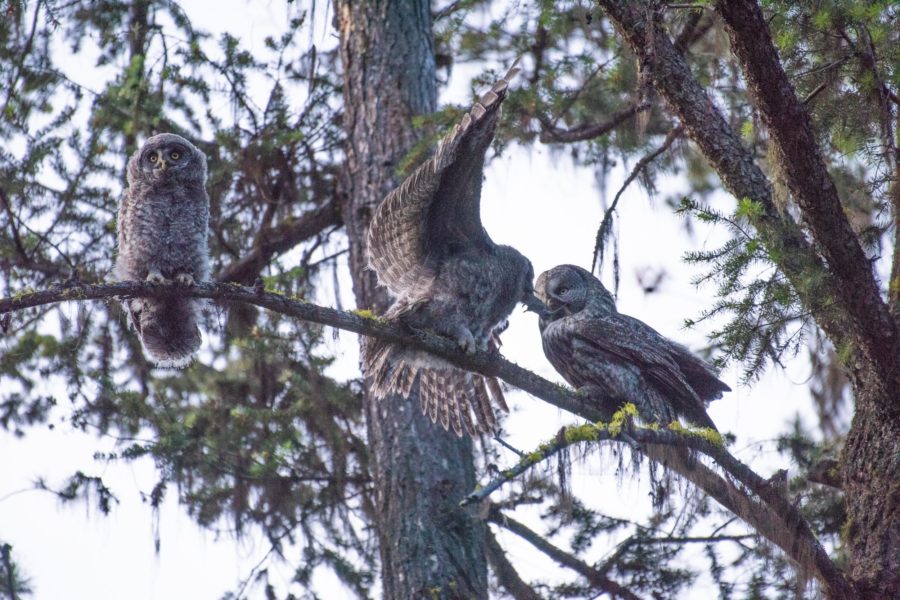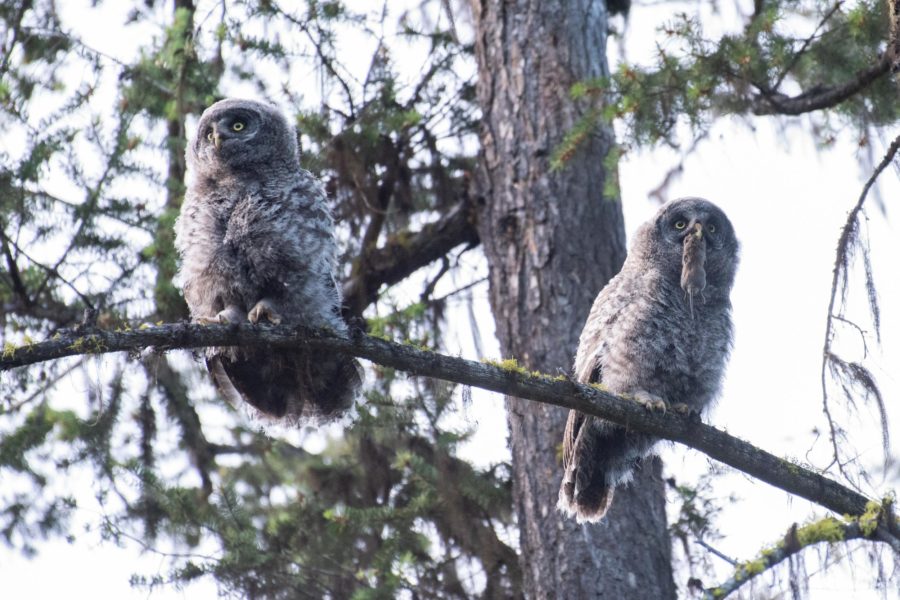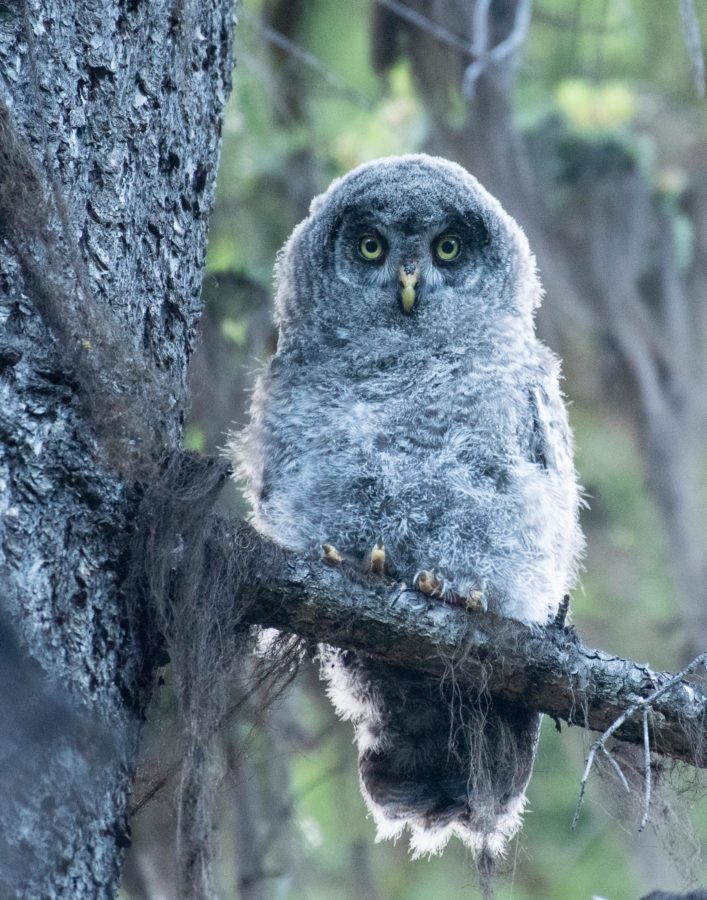The Encounter
By Thomas Bancroft
I cupped my hands around my ears. The sweet evening song of a Swainson’s Thrush drowned out all but the faint babble of the creek down the short draw. A distant second one made an echo of the first. Their opening whistles and spiral flourishes were spectacular. At any other time, I would have stopped and listened, but there was another sound I was straining to hear.

(photo by Julie Vanderwal)
The previous evening, Julie, Craig, and I had come along this trail in Okanogan National Forest just as final twilight had been fading. The “sher-rick” call that repeated every few seconds came from a patch of Douglas firs and lodgepole pines across a small creek. We searched for thirty minutes for the source of the sound, but the light was mostly gone, and we could detect no movement. Craig and I had come back, but right then all I could hear was the thrushes.
This was prime habitat for the gray ghost of the northern boreal forest. Great Gray Owls are large birds, looking bigger than a Great Horned Owl, although actually weighing a little less. A female may approach three pounds, and a male a little over two. They prefer mature forests that have numerous meadows, bogs, and small openings spread through the trees. This species breeds throughout Alaska, Canada and across Northern Europe and Asia, but only in some high elevation dry forests in the Western United States. These rodent eaters are often quite shy, making them difficult to find. In winter, they occasionally fly out of their remote homes, but my searches had always failed to find one.
After moving in the direction of the previous night’s screech, I put a pair of headsets over my ears and pointed my microphone into the woods. Its parabolic reflector would amplify any sound. There it was, the “sher-rick” call of an owlet, persistent but faint, and a little off to our left, and then it stopped. We crept in that direction, scanning up and down trees, looking for a shadow or blob that might be a roosting owlet. Young Great Grays will jump out of their nests when only a few weeks old. Much like a rambunctious teenager, they strive for independence well before they can fly or care for themselves. After tumbling to the earth, the young owls will climb leaning trees to get off the ground and then hop from branch to branch back into the canopy. Usually, they sit right against the trunk on a horizontal branch waiting for their parents to feed them.
Twice more over the next half hour, I put the headsets on to refine the direction toward the begging. Finally, after moving several hundred yards back into the forest, we heard the whining child without the aid of the parabolic reflector. Craig and I eased toward a small meadow with a clump of larches, firs, and pines surrounding it. I stepped around a six-inch lodgepole pine and scanned every tree in front of me, up and down the trunks. Craig, who stood tight by my left shoulder, tapped my arm and pointed almost straight up. There, forty feet up a pine sat a downy owlet on a small side branch. It was right against the trunk as expected, his clawed talons curling over the branch, and his eyes looking straight down at us. I started the sound recorder, setting the microphone down pointing into the coppice and focused my long lens on the owlet. As my camera started to capture pictures, Craig, again, tapped my shoulder pointing this time across in front of me.

Two owlets, both with slightly longer wing and tail feathers than the first, sat about two feet apart on a horizontal branch nearly forty feet up and one gave that “sher-rick” call while they both stared right at us. Their dark eyes gave the impression of curiosity and amazement in seeing these strange two-legged creatures that had walked into their home. All three seemed totally unafraid of us. As I focused my camera, an adult flew silently into the frame, gliding up to land beside the right, screeching owlet where it passed a vole from its mouth to the young, and then dropped off the branch flying back through the forest. The ghost had come and gone.

The breath slowly left my lungs as I continued to stare at the one with a vole hanging from its mouth like a long piece of thick brown licorice. These owls are not rare in their prime habitat, but because these dry interior montane forests are remote and inaccessible, few people have the chance to see one. Adults hunt from perches, and a perfect hunting site is a short tree on the edge of a meadow where the bird can scan for rodents. The facial feather disk on their oversized head directs sound to their acute ears, and they hunt almost entirely by hearing the prey. In winter, these owls can plunge through a foot or more of snow to snare a mouse or vole. Pocket gophers burrow through the soil and are another favorite food.
After a minute, the owlet wolfed down the vole in one giant swallow, and then flew behind trees to land precariously on the top of a subalpine fir where it swayed back and forth in the breeze. Its sibling followed it back into the forest. The adult came in again, landing in the middle of the thicket where it glared right at me while another vole hung from its mouth. Then the second adult arrived also with something in its mouth. It was as if these two predators had flown down to the local corner store for a snack of fresh live meat for the children.

For 30 minutes, I stood watching silently while Craig snuck to my right to see if he could spot where the other two had gone. An adult came in at least twice more but never to the one above my head. That baby yawned a few times, stretched its wings, flexed one or the other foot, but never moved. Occasionally, it became bored of us and stared into the forest. It never begged or seemed distressed that a parent didn’t come visit. The light was fading, and we decided to back out of this place and leave the owls to their own. As we strolled through the forest, the occasional screeches from the owlet pushed us along, and a cloud of mosquitos buzzed around our heads. Neither of us thought to swat at those that feasted on our blood.